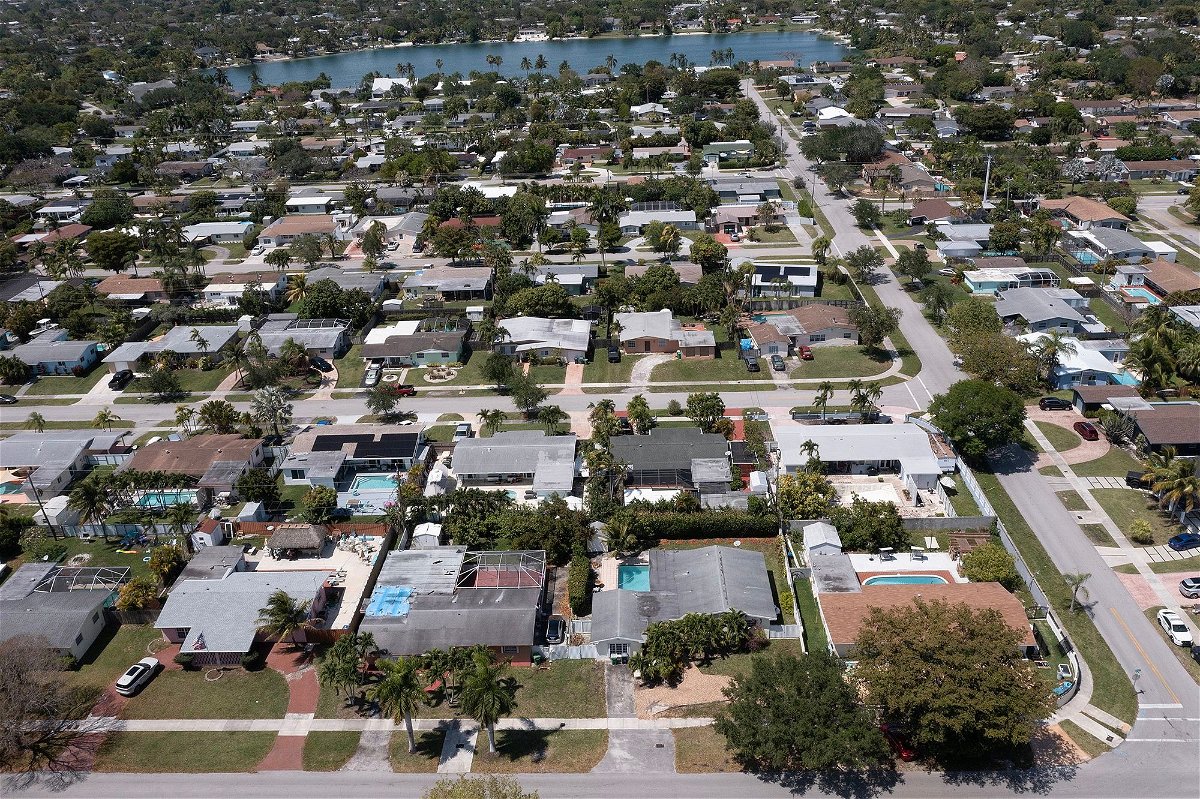Here’s why home prices stayed high in May

In this aerial view
By Anna Bahney, CNN
Washington, DC (CNN) — Home prices remained high in May, dropping slightly from a year before when prices were near record highs and notching a monthly gain from April, according to the latest S&P CoreLogic Case-Shiller US National Home Price Index released Tuesday.
“The rally in US home prices continued in May,” said Craig Lazzara, managing director at S&P DJI. “The ongoing recovery in home prices is broadly based.”
Before seasonal adjustment, prices rose in all 20 cities in May, as they had also done in March and April. Seasonally adjusted data showed rising prices in 19 cities in May, repeating April’s performance. The outlier is Phoenix, down 0.1% in both months.
Month over month, home prices rose in May for the fourth consecutive month. The national index rose 0.7% in May from April, after seasonal adjustment. Both the 10-City and 20-City composites saw increases, too, rising 1.1% and 1%, respectively. Before seasonal adjustments, the national index rose 1.2% from April. May’s increase comes after an uptick in February that snapped a seven-month streak of month-over-month declines.
Year over year, prices continued to decline. The National Composite is 0.5% below its May 2022 level, with the 10- and 20-City Composites also negative on a year-over-year basis. The 20-City Composite posted a 1.7% year-over-year loss, same as in the previous month, which was the biggest decline since April 2012.
Regional differences continue to be striking, said Lazzara.
The data shows what he called “The Revenge of the Rust Belt” as the biggest year-over-year prices were in Chicago, up 4.6%; Cleveland, up 3.9%; and New York, up 3.5%.
“It’s been five years to the month since a cold-weather city held the top spot,” said Lazzara. “And that was Seattle, which isn’t all that cold.”
Since May 2018, the top-ranked cities have been sunbelt cities like Las Vegas; Phoenix; Miami; and Tampa, Florida.
Low inventory keeping prices up
May’s data demonstrated the resilience of home prices as buyers took advantage of the month’s relatively lower rates, keeping the pressure on available inventory, said Hannah Jones, economic research analyst for Realtor.com.
“This month’s index data tracks prices for March, April and May, a period during which mortgage rates spanned a 0.5 percentage point range, but largely remained on the low end,” she said. “Slightly lower rates motivated eager buyers to enter the housing market, but dwindling home supply meant that this demand kept upward pressure on prices.”
The housing market remains unaffordable for many buyers, but some areas are seeing high levels of competition as a result of low for-sale inventory.
“Though buyer demand has generally lessened, limited existing home stock means many markets are seeing competition reminiscent of the last few years,” said Jones. “New listings have lagged the previous year’s levels for long enough that the impact has become clear in active inventory, which has fallen year over year for the last four weeks.”
Mortgage rates above 6% mean many homeowners feel ‘locked in’ by their current mortgage rate and are choosing not to sell. Last week the average rate for a 30-year, fixed-rate loan was 6.78%.
Current rates that are several percentage points higher than the 2%, 3% or 4% rates current homeowners bought or refinanced into over the past few years are keeping sellers in place. That is leading to historically low existing home inventory and causing existing home sales to fall nearly 20% year over year, according to the National Association of Realtors.
“We expect this trend to keep playing out as mortgage rates remain elevated for the time being,” said Jones. “Though home prices are likely to continue to cool slightly, limited inventory relative to buyer demand will likely keep prices somewhat afloat. However, these trends vary greatly market to market.”
What’s ahead for the housing market
While much of what happens in housing still depends on the actions of the Federal Reserve and the response in economic activity, looking at the second half of 2023, housing markets are poised to continue normalizing, following the highly unusual pandemic experience, said George Ratiu, chief economist at Keeping Current Matters, a real estate insights and analytics company.
For reference, he said, it may be useful to reflect on pricing trends during the 1970s and early 1980s, the last time the US economy experienced a similar period of high inflation.
The median price of a new home was about $33,000 in 1973. By 1983, partly spurred by high inflation, the price rose to $75,500, and it continued rising to $126,100 by 1993.
“Notably, those decades saw high inflation, sharp monetary tightening and several recessions,” he said. “While today’s economy and markets are in some ways different, the cyclical nature of real estate remains a common thread. With a large demographic cohort coming of homebuying age and not enough homes, prices will continue to reflect market dynamics.”
May’s Case-Shiller data highlights housing markets displaying the return of seasonal trends, Ratiu said, following a slowdown during the second half of 2022 and a cooler pace during the winter months. Generally, home price momentum has been on an upswing in the first five months of this year.
“It is worth noting that market data are coming up on last year’s record-high prices, notched during May and June,” he said. “The slight year-over-year price decline represents a significant sign of market momentum, as well as a return to more typical seasonal trends.”
The rebound in prices over the past five months has gone against many forecasts made at the start of the year, Ratiu said.
“Real estate analysts and headlines had expected housing markets to slide into a deep recession following last year’s aggressive monetary tightening, coupled with sharp inflation and the attendant surge in mortgage rates.”
That isn’t happening.
Still, he added, residential real estate markets remain out of balance, with demand far outpacing the limited inventory of available homes.
“As home buyers, buoyed by a solid job market and rising wages, accept current mortgage rates as the new normal, even a moderate pace of transactions will keep upward pressure on prices during the peak summer season,” Ratiu said. “We can expect prices to show a typical return to historical patterns as we move into the second half of the year.”
The-CNN-Wire
™ & © 2023 Cable News Network, Inc., a Warner Bros. Discovery Company. All rights reserved.



